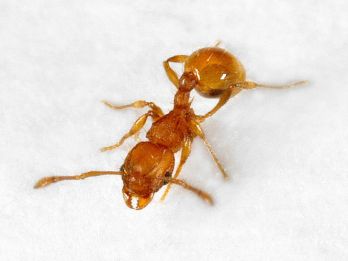Electric ant
The electric ant (Wasmannia auropunctata), or little fire ant, is part of the tramp ant group. This is an invasive ant species that can survive in new environments with an absence of their natural enemies.
Background
Electric ants spread mostly through human activity with the movement of plants, plant products or edible material. Once the ant has established it is known to spread up to 170m per year.
This species is native to Central and South America. It was first found in Queensland in May 2006 at Smithfield, a northern Cairns suburb. The electric ant has since been detected in several areas in Far North Queensland. It has not been detected in South Australia.
Biosecurity Queensland is undertaking an electric ant eradication program – see Queensland Government farms, fishing and forestry for the latest information.
Impacts
Electric ants prey on and compete with other insects and can displace large numbers of native ants.
They inflict painful, burning stings on wild and domestic animals and on humans. One ant can sting many times and the reaction varies from moderate to severe pain and swelling, which can last several days.
Identification
Electric ant workers are monomorphic, displaying no physical differentiation. They are about 1.5 mm long and light golden brown in colour. The queens are about 4 mm long and are similar in colour to the workers.
Several queens and large numbers of workers, pupae, larvae, and eggs make up an electric ant nest.
Behaviour
Unlike other fire ants, electric ants are slow moving and not likely to defend themselves in a large swarm. They are less aggressive and will sting only when pressed upon. They move slowly enough to go unnoticed; if someone is being stung but no ants are seen, electric ants are often the cause.
In their natural outdoor locations, they consume honeydew that is secreted by aphids and scales, plus protein from feeding on dead and living arthropods.
Habitat
Nests are usually found beneath forest floor debris, in tree crotches, and under flowerpots. They rarely enter homes, but nests have been reported in structural wall voids and in palms or palmettos plant sheaths.
In search of food, electric ants trail along sidewalks and foundations up around buildings. Indoors, ant trails are most likely to be found along baseboards.


